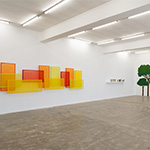Curating an exhibition to mark a gallery’s anniversary is both a moment of reflection and an active engagement with its history, through the lens of the present. It is clear that the particular program of Sfeir-Semler Gallery is rooted in two distinct contexts that shaped it over the years. First in the West, in Germany’s Kiel and Hamburg, then, beginning in 2004, in the Arab world, with the opening of a space in Beirut in 2005 marking a definitive turning point. That moment, fueled by the desire to make contemporary art accessible to local audiences, acknowledged the vitality of the local art scene in Lebanon.
From the outset, the gallery’s programming leaned toward the socio-political, addressing issues rooted in the region while exploring broader questions of memory, identity, and the complex relationship between the Middle East and the West. Over time, a clear direction emerged, defined by singularity, and a deep commitment that drew the attention of collectors and art professionals alike, while fostering a “family” of artists united by a shared conceptual and critical space.
There was the generation of Walid Raad, Akram Zaatari, Marwan Rechmaoui, Wael Shawky, Taysir Batniji, Khalil Rabah, Yto Barrada and Rabih Mroué. There were also moments of renewed engagement with Arab modernism. Exhibitions dedicated to MARWAN, Etel Adnan, Aref el Rayess or Samia Halaby aligned with a growing interest among institutions and art historians in revisiting the region’s modernist legacy, one in which these artists now hold a central place. The gallery also turned its attention to a younger generation, including Lawrence Abu Hamdan, Mounira Al Solh, and Rayyane Tabet, and more recently artists like Dana Awartani, Alia Farid, Tarik Kiswanson, Sung Tieu, and Dineo Seshee Bopape.
With this evolving roster, Sfeir-Semler has largely contributed to promoting, in the Arab world, artistic forms such as video, photography, and performance—moving beyond the traditional categories of painting and sculpture. This commitment to conceptual art and to expanding the field of artistic practices is not surprising, considering the gallery’s early programming choices, with artists like Robert Barry and Ian Hamilton Finlay, or later, Hans Haacke.
Marking Sfeir-Semler’s 40th anniversary in Germany and 20th in Lebanon, The Shade unfolds at a particularly charged moment, when the tumult of global events is impossible to ignore. Traces of these realities resonate throughout the works on view, with most of the participating artists choosing to present recent works, never before shown in Beirut, that hold particular meaning for them today. Echoes of recent history surface in Wael Shawky’s Al Aqsa Park, a video centered on one of the most potent symbols of the Israeli-Palestinian conflict; in Rabih Mroué’s installation Again We Are Defeated, which grapples with the persistent violence across the region; and in Walid Raad’s Festival of Gratitude, a series of birthday cakes dedicated to dictators and tyrants like Saddam Hussein, Hafez al-Assad, and Recep Tayyip Erdoğan—gaudy confections drenched in color and cream.
Yet the exhibition also gestures toward possible worlds. Marwan Rechmaoui’s tree evokes themes of rebirth and childhood, while Dana Awartani’s large-scale installation from the series Come Let Me Heal Your Wounds, Let Me Mend Your Broken Bones reflects on the destruction of heritage sites through a poetic act of repair. Dineo Seshee Bopape’s landscapes draw on the postcolonial memory of South Africa, engaging with identity, resilience and renewal. In Tarik Kiswanson’s video, Ode to Joy – the anthem of Europe – is reinterpreted by children from immigrant communities in the Parisian suburbs. Khalil Rabah’s Olive Trees series offers a vital vision of hope and continuity. And there is of course the poetry in Etel Adnan’s landscapes, which have accompanied us for many years.
The title of the exhibition, The Shade, shrouds it in mystery. Shadows carry a wide range of symbolic meanings, shifting from one historical moment to another, from one culture to the next. They may suggest what is hidden or repressed, or what is investigated in secrecy. But here the reference draws from Carl Jung’s notion of the “shadow” as a space of untapped potential—an opportunity for transformation, where what has long been suppressed might finally emerge.
In Renaissance painting, shadows played a crucial role in sublimating light, serving as a fundamental element of visual composition to capture the world.
Text by Jean-Marc Prevost
Press release from Sfeir-Semler Gallery
Image: Installation view of The Shade, curated by Jean-Marc Prevost, Sfeir-Semler, Karantina, Beirut, Lebanon, 2025. Image courtesy of the artists and Sfeir-Semler Gallery Beirut / Hamburg



